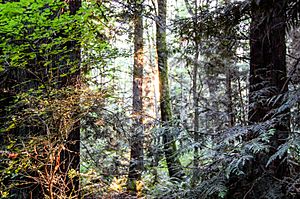Japanese Gulch facts for kids
Japanese Gulch is a beautiful natural area in Snohomish County, Washington. It covers about 1,071-acre (4.33 km2) of land. The City of Mukilteo owns 147 acres of this special place. This part includes a dog park, waterfront access, open spaces, and a community garden. Japanese Gulch has a rich history and many winding trails. It brings amazing natural beauty to a growing city area. People who love to hike, bike, and enjoy nature have explored this treasure for over 30 years.
History of Japanese Gulch
In 1903, a company called Mukilteo Lumber Company started its business here. Later, it became the Crown Lumber Company. It operated until 1930. Many workers were Japanese immigrants. They lived with their families in company houses. This area became known as "Jap Gulch." Later, its name was changed to "Japan Gulch" and then "Japanese Gulch." Most Japanese workers moved away when the Crown Lumber Company closed.
During World War II, Paine Field and Japanese Gulch became important. They were used as a defense spot. This helped protect the Bremerton Shipyard and the Boeing plant in Seattle. After the war, the military use ended. The Boeing plant at Paine Field grew. A railroad was built in the 1960s. This railroad carried materials to and from the Boeing plant. This railroad track is very steep. It is the steepest standard gauge railroad in America, with a 7% incline. This railroad divided Japanese Gulch into two parts. In the 2000s, people also thought about extending Paine Field Boulevard (SR 525 Spur) through the gulch.
In late 2007, a company wanted to buy the land. They planned to build an industrial park there. This made many people in the community upset. It started a movement to save the gulch from being developed.
In 2014, the City of Mukilteo bought 98 acres of the property. They paid $5.4 million to the Metropolitan Creditors Trust. This purchase helped save the park for everyone to enjoy.
Wildlife in Japanese Gulch
Japanese Gulch is home to many different animals. You might see pileated woodpeckers, which are large birds with red crests. black-tailed deer also live here. Look for great blue herons near the water. You might even spot coyotes.
Helping Fish in Japanese Gulch
From June 2009 to December 2010, the City of Mukilteo worked with a company called Confluence Environmental Company (CEC). They wanted to help fish move upstream in Japanese Gulch. First, they studied the stream and the surrounding area. This helped them understand what was stopping fish from swimming upstream.
They found places where fish could not pass. These were often culverts, which are tunnels for water under roads. The team built special "fish ladders" at these spots. These ladders helped fish like Coho salmon swim over the barriers. They did this for much less money than expected. The team also found an old stream path. They were able to redirect the water back into this original path. This made the stream channel twice as long. It created more places for fish to live and grow.


